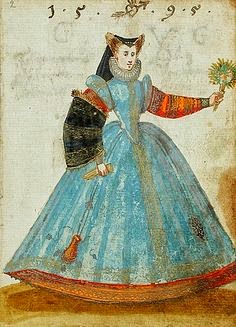Its been a while since I posted any updates, but the stitching never stops I promise. Over the winter I participated in the Realm of Venus Fabulously Fashionable Fur Competition. While I didn't win, I gave the other extremely talented ladies a run for their money and I am very happy with my end results. Here are some brief snippets of my documentation. Please enjoy and go visit the competition page to see the work of the other talented costumers.
Description and History of Renaissance Muffs
The earliest documentation on muff comes from Italy around 1550. By the late sixteenth century, muffs were becoming a popular winter accessory in Europe. From Italy to England women of means were embracing these fur or silk lined envelopes to warm their dainty hands. We have wardrobe accounts for many notable women who owned muffs including Duchess Eleonora di Toledo and Queen Elizabeth I.
|
Elizabeth I owned several muffs which she paid her skinner, Peter Bland, to line with hare and sable furs (Arnold 193). Queen Elizabeth’s god-daughter, Eleanor Verney, was painted holding a heavily embroidered muff around 1590. The popularity of the muff was widespread among women of all ages. |
Materials Cotton Batting Metal Thread Rabbit fur Rayon Velvet in place of Silk Velvet Buttons made from metal thread and wooden beads. Sewing threads Needles Freshwater Pearls Process Step 1: Prepare the Velvet Cut velvet to size and finish edges to avoid excess fraying. The velvet rectangle was cut to 17 by 25 inches. Then draw out the design to be couched in chalk. In period the design would have been pricked and pounced on the design. After the design is transferred to the fabric, it may be inked in place. Instead of inking I ensured the design did not disappear into the pile or rub off by taking some thread and basting over the design. |
Step 2: Embroidery Couch the metal thread over the design using silk thread as the passing. Silk was much easier to use and the couching on the previously mentioned doublet at the New York Metropolitan Museum of Art appears to have sections couched in silk. This design is based on one from a period embroidery book printed in 1534. After the couching was completed basting stitches were removed and small freshwater pearls were stitched into the design. |
Step 3: Buttons Thread covered buttons were widely used in 16th century Europe. I cannot document these buttons being used specifically on muffs, but there are similar looking buttons in Vecellio’s woodcut of a Venetian noble woman. I used the directions given in the Tudor Tailor to make these buttons with DMC “gold” purl thread. |
 | Step 4: Piece the Fur This muff is lined in fur. There are extent examples of muffs which are lined in silk, but Cesare Vecellio says the many Venetian noble women would wear fur lined muffs during the winter. While Vecellio does not specifically state rabbit fur was used, it is listed in Elizabeth I of England’s wardrobe accounts for her muffs. To cut the fur to size I used a utility knife and cut into the underside of the fur. The trimmed rabbit furs were then sewn together with a modern leather needle and silk thread. |
Step 5: Batting Insert To create padding that would sit well inside the muff I pad stitched 6 layers of cotton quilt batting using linen thread. Step 6: Assemble muff Assembling the muff began with basting a seam allowance in place around the edge of the velvet. I then basted the padding on the edges of the seam allowance and the button loops. Next I stitched the fur onto the velvet seam allowance and added the metal thread buttons. |
Sources Anguissola, Sofonisba. The Artist’s Sister Minerva Anguissola. Milwaukee Art Museum. Number: L1952.1 Arnold, Janet. Queen Elizabeth’s Wardrobe Unlock’d. Leeds: Maney Publishing. 2008. “Blouse.” Italian, 16th century. Metropolitan Museum of Art, New York City. Accession number 41.64 “Doublet.” European, 1580. Metropolitan Museum of Art, New York City. Accession number 1978.128 “Extent Muff.” Italian 1550-1600. Museum of Fine Arts Boston. Accession Number: 43.1827 Isis. “Meet Pandora the Fashion Doll.” 9/25/13. Accessed 1/10/14 Landi, Roberta Orsi and Bruna Niccoli. Moda a Firenze 1540-1580 Edizioni Polistampa: 2005. Mikhaila, Ninya and Jane Malcolm-Davies. The Tudor Tailor. Hollywood: Quite Specific Media Group. 2006. Schartzenberger, Johan. Patterns Book of Embroidery: 1534. Berkeley: Lacis Publications: 2003. Vecellio, Cesare and Margaret F. Rosenthal. Habiti Antichi et Moderni: The Clothing of the Renaissance World. New York: Thames & Hudson: 2008. |










Comments
Post a Comment